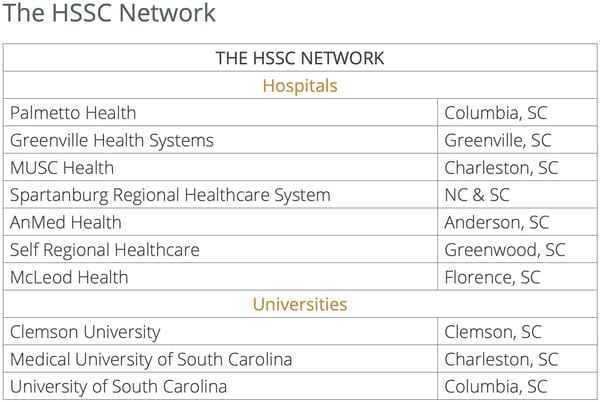
Our Journey With a Health Research Exchange
The Client
Smile Digital Health CTO, James Agnew, was very excited about jointly presenting with HSSC CEO, Mr. Kenneth Deans, in what promised to be yet another demonstration of the breadth and depth of FHIR, as part of the HL7 FHIR Roundtable in New Orleans (Dec 5, 2017).
Health Sciences South Carolina (“HSSC”) was established in 2004 as the first statewide health data and research collaborative in the United States. Today, HSSC enables multi-institutional health research through its Clinical Data Warehouse and associated governance and research tools. Included in the HSSC network are over 6,300 beds, 519,216 in-patient admissions, and 4,681,306 outpatient visits in 2016. The member healthcare institutions are listed on the side followed by university partners.
HSSC and the Smile team developed a FHIR-based Clinical Data Repository infrastructure which spans several facilities. In this architecture, each facility is able to have a dedicated repository of clinical data which is populated in real-time based on feeds from various hospital EHR systems. Hospital data is normalized into FHIR Patient, Encounter, Condition, Observation, and other resources. The data infrastructure is then combined with an EMPI to provide standardized research data reporting, and to enable SMART on FHIR apps with a longitudinal view of data across institutions. This presentation won several awards including Presentation of the Day and Best In Show.

The Challenge
The challenge faced by HSSC is multilayered. Firstly, these clinical systems are integrated using point-to-point connections. Secondly, the research data is being stored in standalone databases as if they exist in their own islands. Finally, to make matters more complicated, the two ecosystems do not communicate with one another in a real-time manner.
The growing availability of health data in various large systems such as Electronic Medical Records (EMRs), Pharmacy systems, and Laboratory systems gives researchers a range of opportunities in improved understanding of every aspect of human health and disease, and an evidence base that can help guide health-related decisions made by care providers and their patients.
For researchers working within the HSSC community to achieve their objectives, they perform computerized searches of such patient medical information for a better understanding of disease patterns, treatment efficacy, and the contribution of genetic and other factors in health. In order to maximize the utility of health information stored in clinical systems, there needs to be a real-time link between research systems and clinical systems.
Therefore, for researchers to make use of clinical data, they must request to receive snapshots of data at any given time and then work with these data for the purpose of their research. Even though this approach may be sufficient for some research endeavours, having real time access to a longitudinal and normalized data set has many advantages. In order to gain a better understanding of patterns it is important for researchers to monitor these encounters of their subjects with the healthcare system over time, regardless of where they were treated. In such a manner, the completeness of data patterns is addressed by placing the patient at the center of the information.
The Solution
The use of a centralized repository where data from various clinical sources can be aggregated and normalized in real-time and made available for sharing among various research databases.
Such an approach increased the research collaboration by allowing for the ability to maintain data in multiple clinical data models which in turn helps in expanding basic knowledge and improving patient care.
In order to have a scalable research data platform, there is a need for the clinical data to be available to researchers though an architecture that would provide a real-time link between clinical data and the research databases while reducing the maintenance cost over time.
By using Smile as an integral part of the proposed architecture, we were able to significantly increase the interoperability and availability of healthcare data to research communities and most importantly we were able to deliver this objective without favoring a particular EHR technology or a vendor. All specific technical platform requirements were deeply rooted in existing standards such as FHIR and were designed in a way to give HSSC full access to their data without any vendor lock-in. Therefore, the final system is highly flexible to allow for inputting, outputting, and migration of data at any given time.
